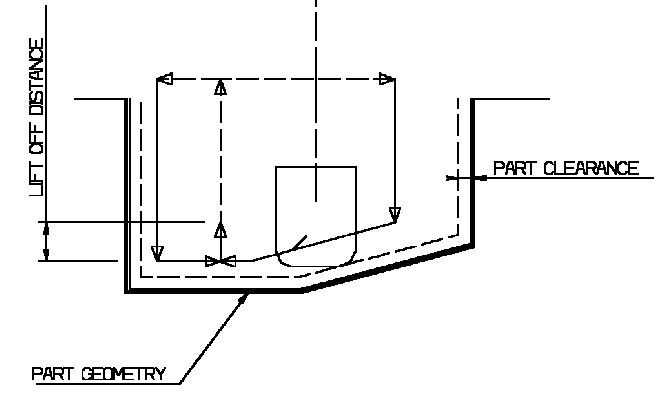The information in this section will help you create and edit Ramp Recess Turning operations in your manufacturing program. This type of operation is suitable for machining hard materials using round ceramic inserts, thereby minimizing wear and cutting stress.
The Ramp Recess Turning operation allows you to machine a recess by means of a One Way or Zig Zag tool motion.
You can specify:
The following topics are dealt with in the paragraphs below:
The following tooling may be used:
Note that the following attributes may influence machining (they are located on the Insert-holder's Technology tab):
These attributes take tooling accessibility into account and may reduce the
machined area.
However, you can use the Insert-Holder Constraints option on the
operation editor to either ignore or apply these tooling attributes. You can
replay the operation to verify the influence of these attributes on the
generated tool path.
Note that the Insert-Holder Constraints setting does not influence the Flank Gouging Angle or the Entry and Exit Flank Angles defined in the operation editor.
Part and Stock profiles are required. They can be specified as follows:
The following Orientations are proposed: internal, external, frontal and inclined.
The selected Orientation defines the type of geometric relimitation to be done between the stock and part geometry in order to determine the area to machine. For an inclined orientation you must specify the Angle of Incline.
Offsets can be positive or negative with any absolute value. The global offset applied to the part profile is the resulting value of the normal, axial and radial offsets.
In a case like the one shown in the figure below, if the depth of cut is not sufficient, it is not possible to reach the righthand flank.
A warning message is issued recommending you to machine the profile in two
operations.
Other possibilities to work around the problem are:
When a part profile has multiple recesses (that is, a non-convex profile along the cutting direction), only the first recess along the specified direction is machined.

then you can give a Machining Speed value.
Dwell setting indicates whether the tool dwell at the end of each path is to be set in seconds or a number of spindle revolutions.
Feedrates in units per minute are also available for air cutting such as
macro motions and path transitions.
Note that RAPID feedrate can be replaced by Air Cutting feedrate in tool
trajectories (except in macros) by selecting the checkbox in the Feed and
Speeds tab page ![]() .
.
Please note that decimal values can be used for the number of revolutions. For example, when machining big parts that have a large volume, it can be useful to specify a dwell using a value of less than one revolution (0.25, for example).
You can select a tool compensation number corresponding to the desired tool output point. Note that the usable compensation numbers are defined on the tool assembly linked to the machining operation. If you do not select a tool compensation number, the output point corresponding to type P9 will be used by default.
Note that the change of output point is managed automatically if you set the Change Output Point option.
If the output point is consistent with the flank of the recess to be
machined, the output point is changed when the other flank of the recess is
machined.
At the end of the operation, the output point is the same as it was at the
start of the operation. See
Changing the Output Point for more information.
The following
Approach and Retract macros are proposed: Direct,
Axial-radial, Radial-axial, and Build by user.
The selected macro type (Approach or Retract)
defines the tool motion before or after machining.
Various feedrates are available for the approach and retract motions (RAPID, lead-in, lift-off, and so on).
Linking macros, which comprise retract and approach motion can also be used
on Ramp Recess Turning operations.
Approach and retract motions of Linking macros are interruptible. It can be
useful to interrupt an operation when the foreseeable lifetime of the insert is
not long enough to complete the machining.
See Define Macros on a Turning Operation for more information.